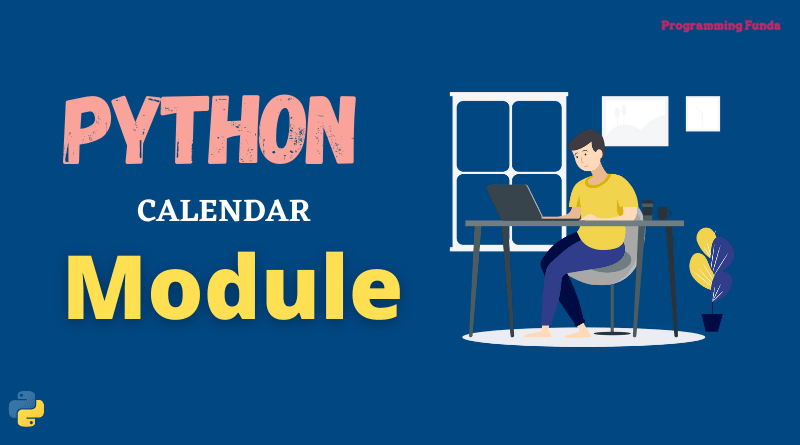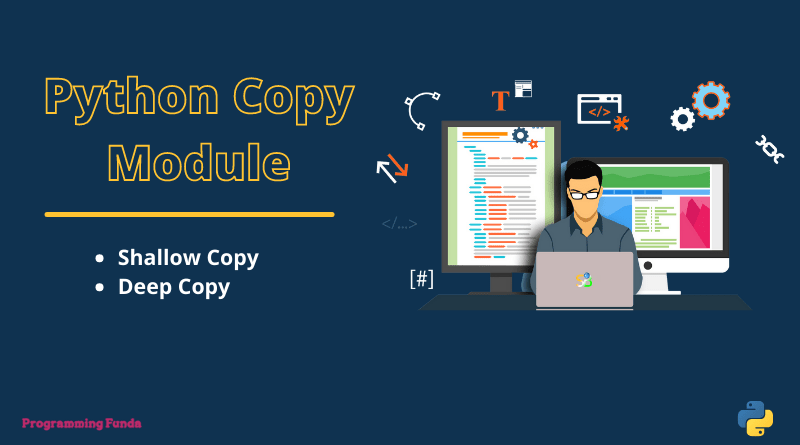In this article, you will learn all about the python calendar module with the help of examples. The calendar module is going to be very useful when you want to work with calendars.
In this guide, we will go through various Calendar useful functions related to the calendar module in Python. By default, the Calendar module uses Monday as the first day of the week but you can change it by using setfirstweekday() function.
Headings of Contents
Python Calendar Module
Python calendar module is used to work with calendars. In the calendar module, there are various functions and classes available which provide additional features.
In the calendar module by default, Monday is the first day of the week and Sunday is the last day of the week.
To use the calendar module you have to import the calendar module using the import keyword.
import calendarAttributes of the calendar module
To get all the attributes and methods of the calendar module, use the Python dir() function.
Example
import calendar
x = dir(calendar)
print(x)Display calendar of a given month
To display a calendar of a specific month of the year, use the month method which takes month and year as an argument.
Example
import calendar
yy = 2017
mm = 10
x = calendar.month(yy, mm)
print(x)class calendar.Calendar
Python Calendar class creates a Calendar object. The calendar class provides various methods that are used for calendar data formatting.
Python calendar module methods
| Methods | Description |
|---|---|
| iterweekdays(year, month) | Return iterator of weekday number |
| itermonthdates(year, month) | Return the iterator of the month number ( 1- 12 ) |
| itermonthdays(year, month) | Return the iterator of the month ( 1- 12 ) of the specified year |
| itermonthdays2(year, month) | Return a tuple consisting of the day of the month number and weekday number |
| itermonthdays3(year, month) | Return a tuple consisting of the a year, a day and a day of the month numbers |
| itermonthdays4(year, month) | Return a tuple consisting of the year, a month, a day of the month, and a day of the week returns a tuple consisting of the year, a day, and a day of the month numbers |
| monthsdatecalendar(year, month) | Return list of weeks in the month of the year as full weeks |
| monthsdays2calendar(year, month) | Return a list of seven tuples of day numbers and weekdays numbers |
| monthdayscalendar(year, month) | Return a list of seven tuple of day numbers |
| yeardatescalendar(year, width=3) | Return the list of weeks in the month |
| yeardays2calendar(year, width=3) | Return the data for the specified year ready for formatting. |
| yeardayscalendar(year, width= | Return the data for the specified year ready for formatting |
Methods
Let’s understand all the methods of the calendar.Calendar class using examples.
iterweekdays()
This method is used to return the iterator of the weekday number that will be used for a week.
Example
import calendar obj = calendar.Calendar(firstweekday = 0) for day in obj.iterweekdays(): print(day)
itermonthdates()
This method is used to return the iterator for the month (1-12) in the year.
Example
import calendar yy = 2019 mm = 11 obj = calendar.Calendar() for day in obj.itermonthdates(yy, mm): print(day)
if you want to change the first weekday then you have to pass firstweekday argument in Calendar class.
Example
import calendar yy = 2019 mm = 11 obj = calendar.Calendar(firstweekday = 2) for day in obj.itermonthdates(yy, mm): print(day)
itermonthdays()
itermonthdays() method is used to return the iterator of the month ( 1- 12 ) of the specified year.
Example
import calendar yy = 2019 mm = 11 obj = calendar.Calendar() for day in obj.itermonthdays(yy, mm): print(day)
itermonthdays2()
itermonthdays2() method is used to return the iterator of the month ( 1- 12 ) of the specified year. The days returned will be a tuple consisting of a day of the month number and week day number.
Example:
import calendar yy = 2021 mm = 7 obj = calendar.Calendar() for day in obj.itermonthdays2(yy, mm): print(day)
itermonthdays3()
itermonthdays3() method is used to return the iterator of the month ( 1- 12 ) of the specified year. The days returned will be a tuple consisting of a year, a month, and a day of the month numbers.
Example
import calendar yy = 2021 mm = 7 obj = calendar.Calendar() for day in obj.itermonthdays3(yy, mm): print(day)
monthdatescalendar()
monthdatescalendar() method is used to get the list of weeks in the month of the year as full weeks. Weeks are the list of seven datetime.date objects.
Example
import calendar yy = 2019 mm = 11 obj = calendar.Calendar() for day in obj.monthdatescalendar(yy, mm): print(day)
monthdays2calender(year, month)
Return a list of the weeks in the month of the year as full weeks. weeks are a list of seven tuples of day numbers and weekdays numbers.
Example
import calendar yy = 2021 mm = 11 obj = calendar.Calendar() for day in obj.monthdays2calendar(yy, mm): print(day)
monthdayscalender(year, month)
Return a list of the weeks in the month of the year as full weeks. weeks are a list of seven tuples of day numbers.
Example
import calendar year = 2021 month = 11 obj = calendar.Calendar() for day in obj.monthdayscalendar(year, month): print(day)
yearsdatescalendar(year, width=3)
Return the data for the specified year ready for formatting.
Example:
import calendar year = 2021 obj = calendar.Calendar() for i in obj.yeardatescalendar(year, width=3): print(i)
yeardayscalendar(year, width=3)
Return the data for the specified year ready for formatting. Similar to yeardatescalendar().
Example
import calendar year = 2021 obj = calendar.Calendar() for i in obj.yeardayscalendar(year, width=3): print(i)
class calendar.TextCalendar
TextCalendar class is used to generate the plain text calendars.
Methods
TextCalendar class provides various methods and attributes.
formatmonth(theyear, themonth, w = 0, l = 0)
This method is used to get the month’s calendar in a multi-line string. It specifies the width of date columns that are centered. If l is given, it specifies the number of lines that each week will use.
Example:
import calendar text = calendar.TextCalendar(firstweekday = 0) year = 2019 month = 12 #formatmonth() with two parameters print(text.formatmonth(year, month)) #formatmonth() with three parameters print(text.formatmonth(year, month, w = 3)) #formatmonth() with four parameters print(text.formatmonth(year, month, 3, 2))
prmonth(theyear, themonth, w = 0, l = 0)
The prmonth() method is used to print a month’s calendar as returned by formatmonth().
Example:
import calendar text = calendar.TextCalendar(firstweekday = 0) year = 2019 month = 12 #prmonth() with two parameters text.prmonth(year, month) #prmonth() with three parameters text.prmonth(year, month, w = 3) #prmonth() with four parameters text.prmonth(year, month, 3, 2)
formatyear(theyear, w=2, l=1, c=6, m=3)
This method is used to get the month’s calendar in multi-line string.It specifies the width of date columns which are centered.If l is given, it specifis number of line that each week will use.
Example:
import calendar text = calendar.TextCalendar(firstweekday = 0) year = 2019 # month calender without width and line print(text.formatyear(year)) # month calender with width print(text.formatyear(year, w = 3)) # month calender with width and line print(text.formatyear(year,3, 2))
pryear(theyear, w=2, l=1, c=6, m=3)
Print the calendar of the entire year as returned by the formatyear() method.
Example:
import calendar text = calendar.TextCalendar(firstweekday = 0) year = 2019 # month calender without width and line text.pryear(year) # month calender with width text.pryear(year, w = 3) # month calender with width and line text.pryear(year,3, 2)
class calendar.HTMLCalendar
Python calendar HTMLCalendar class is used to generate HTML calendar.
formatmonth(theyear, themonth, withyear=True)
This can be used to generate month calendar as a HTML table.
Example:
import calendar # create the object of HTMLCalendar class text = calendar.HTMLCalendar(firstweekday=0) year = 2020 month = 7 # print generated html calendar print(text.formatmonth(2020, 7, withyear=True))
formatyear(theyear, withyear=True)
This can be used to return years’s HTML table.
Example
import calendar text = calendar.HTMLCalendar(firstweekday=0) year = 2020 # generate html table of entire year print(text.formatyear(year, width=3))
HTMLCalendar has the following attributes you can override to customize the CSS classes used by the calendar.
cssclasses
cssclasses returns the list of CSS classes.
Example
import calendar text = calendar.HTMLCalendar(firstweekday=0) year = 2020 # list of the css classes. print(text.cssclasses)
cssclasses_weekday_head
cssclasses_weekday_head property returns the CSS classes used for weekday names in the header now. This works the same as cssclasses.
Example:
import calendar text = calendar.HTMLCalendar(firstweekday=0) year = 2020 # list of the css classes. print(text.cssclass_month_head)
Functions
The calendar module in Python provides various functions to work with calendars.
setfirstweekday()
Python calendar module treats Monday as the first day of the week but you can change it by using setfirstweekday() function.
Example
import calendar calendar.setfirstweekday(2)
firstweekday()
Return the current setting for the weekday to start the week.
Example
import calendar
result = calendar.firstweekday()
print("The first weekday is:- ", result)
isleap()
This function is used to return True if the specified year is a leap year.
Example
import calendar
result = calendar.isleap(2020)
print("The result is:- ", result)
leapdays(y1, y2)
This function is used to return the number of leap years between given years. Here y1 and y2 represent the years.
Example
import calendar leap_years = calendar.leapdays(1998, 2020) print(leap_years)
Conclusion
That’s all about the Python calendar module. The calendar module in Python is going to be very helpful when you want to work with calendar-related tasks because Python calendar module provides classes, methods, properties, and functions to work with calendar.
In this guide, we have covered approx all the useful classes and methods that are helpful when you will work with a calendar.
If you like this Python calendar module tutorial article, please share and keep visiting for further Python tutorials.
Reference of Python calendar module:- Click Here
Thanks for reading.







